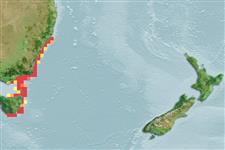分类 / Names
俗名 | 同种异名 | Catalog of Fishes(属, 种) | ITIS | CoL | WoRMS | Cloffa
Teleostei >
Lophiiformes (Anglerfishes) >
Brachionichthyidae (Handfishes)
Etymology: Brachionichthys: Latin, bracchium = arm + Greek, ichthys = fish (Ref. 45335); hirsutus: Name from Latin 'hirsutus' for hairy, in reference to its rough, hairy skin.(Ref. 82446).
More on author: Lacepède.
Environment: milieu / climate zone / depth range / distribution range
生态学
海洋 居于水底的; 非迁移的; 深度上下限 1 - 60 m (Ref. 72490), usually 5 - 15 m (Ref. 72490). 溫帶; 41°S - 44°S, 147°E - 149°E
Southwest Pacific: Endemic to Tasmania, Australia. Has been nearly wiped out by an introduced starfish which preys on its egg clusters (Ref. 27438).
西南太平洋: 塔斯梅尼亞,澳洲的特有種。 曾經幾乎枯竭藉著捕食的一個被引入的海星,它的卵聚集.(參考文獻 27438)
大小 / 重量 / 年龄
Maturity: Lm ? range ? - ? cm
Max length : 15.0 cm TL 雄鱼/尚未辨别雌雄; (Ref. 7300)
简单描述
检索表 | 型态特徵 | 形态测量图
背的软条 (总数) : 19 - 21; 臀鳍软条: 8 - 10. This species is unique in having the following set of characters: esca small, 15-26% (mean 20%) of illicium length (including esca); illicium very slender, no dermal spinules, length 19-20% SL (mean 20%), 2.3-2.4 times in head length; eye moderate, exceeding 5.4 times in head; body entirely covered with close-set, non-imbricate scales; scale bases subcircular with long
unicuspid spinules (except for those closely-associated with pores of the acoustico-lateralis system); spinules originating from middle of scale base, variable in length over body; second dorsal-fin rays 17-19 (mean 18), fin base 61-64 (mean 62%) SL; first ray of first dorsal fin length 0.7-1.0 times length of longest ray of second dorsal fin; anal-fin rays 8-10; pectoral-fin rays usually 7 ; upper body usually covered with fine dark spots or short streaks (rarely with long streaks on head); caudal fin with dense coverage of fine spots, forming a dark submarginal bar in juveniles (Ref. 72490).
Occurs in the continental shelf and inshore waters (Ref. 7300). Occurs in coarse to fine sand habitats in depths of 5-40 m (most commonly 5-10 m). Often found in shallow, shell-filled depressions or near rocks of low relief projecting from the substrate (Ref. 30684). Length only preliminary, replace with better value (RF). Egg masses contain about 80-250 eggs, about 1.8-2 mm in diameter; egg capsules about 3-4 mm diameter. Newly hatched juveniles are about 6-7 mm SL, attaining at least 9.0 cm SL (about 13.0 cm TL), with adults commonly about 6.0-7.5 cm SL (Ref. 72490).
出现于大陆架与近岸水域。 (参考文献 7300) 出现于粗糙的到在深度 5-40 公尺中的细砂栖息地.(最通常 5-10 公尺) 时常发现于浅滩, 满布贝类的凹洼或者在生浅浮雕的岩石的附近从底部伸出.(参考文献 30684) 长度只是初步未确认的, 以更适当的值 (RF) 取代.
Life cycle and mating behavior
成熟度 | 繁殖 | 产卵场 | 卵 | 孕卵数 | 仔鱼
西南太平洋: 塔斯梅尼亞,澳洲的特有種。 曾經幾乎枯竭藉著捕食的一個被引入的海星,它的卵聚集.(參考文獻 27438)
Paxton, J.R., D.F. Hoese, G.R. Allen and J.E. Hanley, 1989. Pisces. Petromyzontidae to Carangidae. Zoological Catalogue of Australia, Vol. 7. Australian Government Publishing Service, Canberra, 665 p. (Ref. 7300)
世界自然保护联盟红皮书 (Ref. 130435: Version 2024-2)
极度濒危 (CR) (B1ab(iii,v)); Date assessed: 30 April 2018
人类利用
工具
特别资料
下载 XML
网络资源
Estimates based on models
Preferred temperature (Ref.
123201): 13.5 - 21.2, mean 15.8 °C (based on 68 cells).
Phylogenetic diversity index (Ref.
82804): PD
50 = 0.7501 [Uniqueness, from 0.5 = low to 2.0 = high].
Bayesian length-weight: a=0.00389 (0.00180 - 0.00842), b=3.12 (2.94 - 3.30), in cm total length, based on all LWR estimates for this body shape (Ref.
93245).
营养阶层 (Ref.
69278): 3.3 ±0.39 se; based on food items.
Fishing Vulnerability (Ref.
59153): Low vulnerability (10 of 100).
